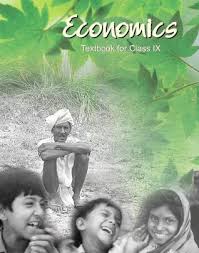Class 9 - Social Science : Economics
Chapter 3 - Poverty as a Challenge

Top Block 1
Question : 1 Describe how the poverty line is estimated in India.
Answer :
A common method used to measure poverty is based on the income or consumption levels. A person is considered poor if his or her income or consumption level falls below a given “minimum level” necessary to fulfil basic needs. While determining the poverty line in India, a minimum level of food requirement, clothing, footwear, fuel and light, educational and medical requirement etc. are determined for subsistence. These physical quantities are multiplied by their prices in rupees. The resent formula for food requirement while estimating the poverty line is based on the desired calorie requirement.
As per 2000 figures; a family of five which is earning less than Rs. 1,640 per month is considered to be living below the poverty line. This figure is Rs. 2,270 per month for the urban area.The expected calorie intake has been fixed at 2400 calories per person in rural areas and 2100 calories in urban areas. A person consuming less than this amount is considered to be living below the poverty line.
Question : 2 Do you think that present methodology of poverty estimation is appropriate?
Answer :
I don’t think that the present methodology of poverty estimation is appropriate because each country uses an imaginary line that is considered appropriate for its existing level of development and its accepted minimum social norms. For example, a person not having a car in the United States may be considered poor. In India, owning of a car is still considered a luxury.
Question : 3 Describe poverty trends in India since 1973.
Answer :
There is a substantial decline in poverty ratios in India from about 55 per cent in 1973 to 36 percent in 1993. The proportion of people below poverty line further came down to about 26 per cent in 2000. If the trend continues, people below poverty line may come down to less than 20 per cent in the next few years. Although the percentage of people living under poverty declined in the earlier two decades (1973– 1993), the number of poor remained stable around 320 million for a fairly long period. The latest estimates indicate a significant reduction in the number of poor to about 260 million.
Question : 4 Discuss the major reasons for poverty in India.
Answer :
There were a number of causes for the widespread poverty in India. One historical reason is the low level of economic development under the British colonial administration. . The low rate of growth persisted until the nineteen eighties. This resulted in less job opportunities and low growth rate of incomes. This was accompanied by a high growth rate of population. The two combined to make the growth rate of per capita income very low. Another feature of high poverty rates has been the huge income inequalities. One of the major reasons for this is the unequal distribution of land and other resources. Despite many policies, we have not been able to tackle the issue in a meaningful manner.
Question : 5 Identify the social and economic groups which are most vulnerable to poverty in India.
Answer :
Social groups, which are most vulnerable to poverty, are scheduled caste and scheduled tribe households. Similarly, among the economic groups, the most vulnerable groups are the rural agricultural labour households and the urban casual labour households.
Question : 6 Describe global poverty trends.
Answer :
The proportion of people in developing countries living in extreme economic poverty— defined by the World Bank as living on less than $1 per day—has fallen from 28 per cent in 1990 to 21 per cent in 2001. Although there has been a substantial reduction in global poverty, it is marked with great regional differences. Poverty declined substantially in China and Southeast Asian countries as a result of rapid economic growth and massive investments in human resource development. Number of poor people in China has come down from 606 million in 1981 to 212 million in 2001. In the countries of South Asia (India, Pakistan, Sri Lanka, Nepal, Bangladesh, Bhutan) the decline has not been as rapid. Despite decline in the percentage of the poor, the number of poor has declined marginally from 475 million in 1981 to 428 million in 2001. Because of different poverty line definition, poverty in India is also shown higher than the national estimates. In Sub-Saharan Africa, poverty in fact rose from 41 per cent in 1981 to 46 per cent in 2001 (see graph 3.3). In Latin America, the ratio of poverty remained the same. Poverty has also resurfaced in some of the former socialist countries like Russia, where officially it was non-existent earlier. The proportion of people living under poverty in different countries is defined by the international poverty line (means population below $1 a day).
Question : 7 Describe current government strategy of poverty alleviation.
Answer :
The current anti-poverty strategy of the government is based broadly on two planks
(1) promotion of economic growth
(2) targeted anti-poverty programmes.
Question : 8 What do you understand by human poverty?
Answer :
Many scholars advocate that we must broaden the concept of poverty into human poverty. A large number of people may have been able to feed themselves. But they do not have education or shelter or health care or job security or self-confidence.
They are not free from caste and gender discrimination. The practice of child labour is still common.
Mddle block 1
Question : 9 Describe how the poverty line is estimated in India.
Answer :
A common method used to measure poverty is based on the income or consumption levels. A person is considered poor if his or her income or consumption level falls below a given “minimum level” necessary to fulfil basic needs.
Question : 10 Who are the poorest of the poor?
Answer :
Women, elderly people and female infants are systematically denied equal access to resources available to the family. Therefore women, children (especially the girl child) and old people are the poorest of the poor.
Question : 11 What are the main features of the National Rural Employment Guarantee Act 2005?
Answer :
The National Rural Employment Act provides 100 days assured employment every year to every rural household in 200 districts. Later, the scheme will be extended to 600 districts. One third of the proposed jobs would be reserved for women. The central government will also establish National Employment Guarantee Funds. Similarly state governments will establish State Employment Guarantee Funds for implementation of the scheme.



